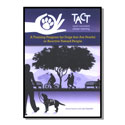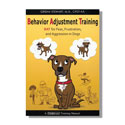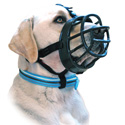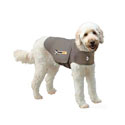Training, science, and teamwork come together in northern CA
It's Friday morning. On a grassy field, people and their dogs are working out. The exercises look something like a standard clicker training class; owners wearing treat bags and dogs heeling closely, faces turned up for the next click and treat. The group is so dedicated and effective in working with their dogs that neighborhood people regularly stop by to watch and say hello, thinking this is just a "good manners" class. It isn't. This is a training group for dogs with aggression issues.
When the group finishes their exercises, they meet at a nearby coffee shop. Clustered together around small tables, they watch videotapes of behavior consultations, discuss casework, problem solve, and create and design treatment plans. They read and review books, discuss research, listen to public speakers, and talk, laugh, and enjoy each others' company. Sometimes they view a video of the morning's work session and offer feedback: three good things the dog did, three good things the trainer did, and one thing to improve upon for both dog and handler. On rainy days, the group foregoes the park and heads right to the coffee shop for tabletop clicker games. Waitresses and customers stop to watch and ask questions.

L-R: Lorril Fong-Jean & Tucker;
Maddy Castillo & Baker
Breakfast often lasts for three hours.
Clearly, JavaDawgs is more than your average dog training group. "This is not a top down training group," explains group founder Lisa Clifton-Bumpass from her home in Hayward, CA. "We function as a team, working for the betterment of each dog-owner team and as a larger team of people focused on bettering themselves as dog enthusiasts. Not all members are on the field at once. Some members work their dogs, others act as training coaches, and others are observing dog body language, timing-criteria setting, and handling skills. All voices and observations are of value in this process as we are all developing our skills as a team."
The accomplishments of this group and its founder have not gone unnoticed. Clifton-Bumpass is winner of the 2005 Association of Pet Dog Trainers (APDT) Outstanding Trainer of the Year Award, an honor she resolutely shares with her JavaDawgs membership. Clifton-Bumpass was unknowingly nominated for the award by the training group, which kept the nomination process a secret until the award was announced. "Although I was the awardee, JavaDawgs members are the success story. It is truly their award; they're the ones doing the work," says Clifton-Bumpass. "The group's dedication to working as a team, learning new skills, striving to become better observers of dog behavior, and learning critical thinking and problem solving is addictive for me. Their improvement continually pushes my skill and creativeness to match them."
Clifton-Bumpass loves what she does. "This is the most rewarding work I have ever done in my life—and I'm a retired disabled police officer. It's extremely rare to have a training group that gives back to me as much as I give to them. In fact, this work is so satisfying that I don't charge for the JavaDawgs service. By helping the group to improve their total package of skills needed to work and live happily with dogs, I have been emotionally rewarded beyond any expectation I had for this career path."
Learning to click
Clifton-Bumpass discovered clicker training in 1998 while training at the Marin Humane Society in northern CA. "I had taken a couple of classes from local teachers before seeing Karen Pryor speak in San Francisco. As a result of her lecture, I was aware that there was a greater world of animal learning than I had ever been exposed to," says Clifton-Bumpass. "I took several clicker group classes at various institutions that always left me wanting more advanced and technical information. In 2000, I enrolled in the San Francisco SPCA Dog Trainer's Academy, which teaches clicker-based training and behavior modification techniques. My skills advanced, but I still felt that I could learn more and have a higher skill level."
After graduating from the San Francisco SPCA and completing a series of Bailey & Bailey workshops, Clifton-Bumpass was dismayed by what she perceived as a substantial lack of understanding in animal learning. "I was disheartened by people using derogatory terms like Clicker Hitler and Clicker Purist when referring to trainers who closely adhered to the laws of learning, curricula design, and the applications of clicker work," she recalls.
After her third level of Bailey classes, which Clifton-Bumpass credits for profoundly changing the way she looked at the process of learning, the responsibilities of teaching, and the fundamentals of operant conditioning, she changed all of her group and private training to exclusively clicker work. "I was the first strictly clicker/reinforcement group class teacher and practitioner in my region. The transition was not easy, but it was very satisfying. When people—professionals and dog owners alike—learned that I was exclusively clicker based, they started searching me out."
Introducing the cue
Before long, the seeds of JavaDawgs began to sprout. "Three years ago, I had two clients with dog-reactive dogs who needed to work with and against another dog in order to take the next step in their behavior modification process," Clifton-Bumpass explains. The dogs' reactivity and aggression problems had been severely worsened, if not caused by, the punishment of traditional training practices. Clifton-Bumpass knew what she was working with. "Both dogs had been in either group classes or private sessions with me, so I was very sure of their baseline skills." They began working together as an ensemble.
At that time, all of Clifton-Bumpass's exercises were designed "on the fly." She wasn't sure what to expect, but the dogs accelerated rapidly and the handlers' skills jumped forward beyond what she had previously experienced in one-to-one private training sessions or group classes. She began adding more people and dogs to the group. "I quickly learned that by designing training sessions geared to the comfort zone and prior learning of both dog and human that both ends of the leash exploded in relaxed skill, awareness, and the art of effective decision-making."
Over time, the group grew from two dog owners to its current size of 31; an eclectic membership that includes breeders, professional dog trainers, a Ph.D. candidate, police officers, obedience and confirmation competitors, search-and-rescue handlers, and everyday dog owners—all with reactive dogs.
The group had become a true entity, and needed a moniker. The name JavaDawgs evolved as part of the group's egalitarian practice. "When we congealed as a group, I asked them to come up with a name," says Clifton-Bumpass. "As in any committee process, many ideas were tossed around. We decided on the name of JavaDawgs in honor of our collective addiction to coffee. We meet early Friday mornings—some people drive for over an hour—so by the end of the training session, we all need coffee! We started going out to a coffee shop. Within a couple of months, we had evolved to watching videos and discussing training plans—and the JavaDawgs of today was born."
Click and treat

L-R: Nella Banworth & Brio;
Maddy Castillo & Just Jack;
Molly Miranda & Bobbie.
JavaDawgs focuses on practicing clicker mechanical skills and training decisions, protocols, behavior, and modification design using applied animal behavior and learning theory. As Clifton-Bumpass explains, "I've always been uncomfortable with the ‘dumbing down' of the knowledge and skills required to train animals, whether it is ‘just' the pet owner, training assistant, or professional trainer. Our language, training exercises, and the sciences of ethology/learning theory are as important to our training toolbox as are the leash, clicker, reinforcers, and human/dog team. All of my clients are required to do a lot of reading and basic skill building. Informing the potential client/student is part of the interviewing process. I fully disclose that this is not ‘light switch' training, but a shift in understanding that will require new language and new skills building."
Clifton-Bumpass has a knack for making the science of training clear, interesting, and relevant.
She looks for common ground in communicating with clients. "I use whatever analogies work for the specific client/trainer to convey that learning and behavior are far more complex than we have understood in the past," she explains. "This means whatever it takes to break the ‘cell membrane' of resistance to new information by using a person's other interests insights, passions, and interests as effective tools to communicate effectively. If their private passion is gardening, then all of my analogies are focused there, if they are car nuts, I shamelessly mine those lines of thought. If they are gourmet cooks—I use that. This analogy system seems to be very effective and is easily transferable to different special interests that people have. It comes from Bob Bailey's brain surgeon analogy: ‘Who would you want to do your surgery? Someone who has just read about it in various books? Or someone who has practiced their skill many times and has perfected their eye hand coordination?'"
The group concentrates on reading body language, which is essential in working with reactive dogs. Clifton-Bumpass teaches owners how to read fundamental dog body language "for signs of stress and relaxation with a focus on finding the comfort zone of the dog to optimize learning," she explains. "I avoid ethospeak, the mis-application of dog body language, and reward the owner as they begin to read their dogs' stress levels. I also study the body language of the owner for signs of stress and anxiety, to avoid the pitfall that will slow their learning."
Call of the clicker
The impact of JavaDawgs impact is considerable, on and off the field. So far, three of Clifton-Bumpass's clients have gone on to the San Francisco SPCA Academy, under Jean Donaldson. One of those trainers, Daphne Robert-Hamilton, was motivated to become a trainer largely on account of her experience with JavaDawgs.
"I had absolutely no idea that there was another form of training other then traditional training until I met Lisa," explains Robert-Hamilton, of Morgan Hill, CA. "I was good with force, intimidation, coercion, and pain. I'd been a horse trainer for 12 years so it was natural for me to transfer my training biases to dog training. My private trainer basically told me that some people used gimmicks for training but I never explored it further. I never knew about humane training until I met Lisa."
Robert-Hamilton had been competing in AKC obedience trails with Echo, her Doberman pinscher (one of the original JavaDawgs). "The traditional training that I was doing severely compromised my relationship with him and his performance in the ring," she says. Echo had had several incidents with neighbors' loose dogs on his property and become very reactive to the sight of any dog. On account of traditional training techniques, Echo became so deeply sensitized to equating seeing other dogs and punishment that his reactivity onset started when a dog came into his field of view, regardless of distance. "He became very anxious and developed several anxiety clusters," Robert-Hamilton explains. "I immediately fired my private trainer and was ready to drop my competition ‘life' for the sake of his emotional well-being."
Fortunately, help was at hand. "I had met Lisa at a flyball class that Chris Bond and her husband co-taught," Robert-Hamilton explains. "I asked Lisa for some help with Echo so that we could re-build our relationship."
Robert-Hamilton began working with Clifton-Bumpass. They started with simple obedience type behaviors and then transitioned to a desensitization and counter conditioning program to help Echo with his extreme sensitivity to unfamiliar dogs on/off leash. The experience has been formative, for Robert-Hamilton as well as Echo.
"The fundamental principle is building a relationship between you and your dog," says Robert-Hamilton. "You learn about dog language and the best methods to teach behaviors for management and reduced arousal levels. It's very touching to see a relationship grow and develop, and how committed the select few are. The benefits of this class are tremendous—mechanical skill development, observational skill development, understanding, and awareness of dog body language, management solutions—building strong reliable performance behaviors, changing a dog's conditioned emotional response and being happy to be on this planet with other unfamiliar people and unfamiliar dogs. It definitely improves the dog's quality of life."
Ultimately, Robert-Hamilton decided to become a certified trainer. "I had left the horse industry and wasn't sure which path to take. Lisa and my husband both suggested that I become a dog trainer. I felt that the responsibility of becoming a dog trainer was very important and decided, with Lisa's suggestion, to attend the San Francisco SPCA Academy for Dog Trainers," she says. "The Academy was my stepping stone into learning all that I could on applied animal learning theory; the sciences behind humane training. I have a strong opinion that we should know the science, because it creates a deeper understanding of behavior. That deeper understanding, along with personal skill development, is an unending process. It's a quest to be better than you are, for the benefit of the animals we work with."
Clicking just feels better
Like Robert-Hamilton, Trish Desloover of Castro Valley, CA, was new to clicker training when she met Clifton-Bumpass. "I met Lisa at a puppy class she was teaching. It was my first introduction to positive-reinforcement based training, and I had little knowledge about canine behavioral science. Previous obedience classes included dominance and choke chains. I had never experienced the rush and bonding that is evident with positive reinforcement. For me the clicker has accelerated the learning of a specific behavior beyond measure and has led me to a quest for behavioral knowledge. Some of my educational background in childhood and human development is similar—and it intrigued me to find out how similar the theories are."
Molly Miranda, of Fremont, CA, was already dedicated to clicker training when she found JavaDawgs. She came to the group when it became clear that her dog Bobbie, a Springer spaniel, was having trouble. "A few months after adopting my dog, I was desperately searching for a way to relate to my mostly untrained, impulsive, energetic, intelligent, unfriendly (to human strangers and all dogs) dog. I did not realize the scope of the behavioral issues at the time," she says. The science aspect first attracted her to the clicker approach. Miranda started clicker training by herself, reading Karen Pryor's Don't shoot the Dog and Clicker Training for Dogs among others, and concluded that this would be the most efficient and healthy method.
"In the beginning it was very exciting to experience my dog choosing to happily pay attention to me and the clicker instead of explosively reacting. Actually, I was hopelessly hooked after seeing my dog's face light up the very first time we tried clicker training." She enrolled in classes for dog-aggressive dogs that incorporated the clicker, and attended the Berkeley ClickerExpo. Miranda was referred to JavaDawgs when the trainer she was working with stopped teaching to return to school.
"JavaDawgs is definitely much more rewarding for me than other group training experiences," Miranda explains. "We try to keep updated on current research, and that's great for me because I'm a ‘what's new in science?' junky. I also get to learn about a broad range of things including click timing and body language presentations of different dog breeds. The biggest reward, of course, is the continuous improvement for both me and my dog. With each little success, my worst fears about losing my dog to something other than old age or disease, diminish. I know that might sound overly dramatic, but that's what is really in my mind sometimes."
Birds of a feather

L-R, front: Charlie Foster, Chris Bond,
Leslie Bosserman, Liz Weir; middle:
Gretchen Foster, Tammy McCormick,
Lisa Clifton-Bumpass, Daphne
Robert-Hamilton, Lorril Fong-Jean,
Sydney Nishiyama, Barbara Dwyer;
rear: Janet Norris, Molly Miranda,
Peter Cheng,Trish DeSloover.
It's difficult to live with an aggressive dog, and owners often deal with emotional angst. Many people who have not experienced the far-reaching effects of having a reactive dog may not realize how profound the experience can be. Finding an oasis of nonjudgmental peers can offer significant relief. Trish Desloover appreciates such an affinity between JavaDawgs members. "This is a great group of people solely committed to the betterment of society and the animals that we share our lives with. There is something about sharing the bond of having a reactive dog that brings us together," she says. Molly Miranda agrees: "I get to talk to the other people, which relieves the feeling of isolation."
This camaraderie is also appealing to Charlie Foster of San Jose, CA. He and his wife Gretchen are the owners of Sunny, a briard with severe fear issues that have led to aggressive reactions. "If nothing else, JavaDawgs has helped me understand that Sunny's issues are not our fault and being able to release the guilt I felt has given me a huge lift," Foster explains. "Understanding that her issues stem from chemical or neurological sources has made it possible for me to try to look at the situation from her point of view. Feeling comfortable and accepted by the JavaDawgs group has made me enjoy working with her and learning instead of it being a burden."
The group's scientific leaning has inspired Foster to learn more about dogs, animal behavior theory, and training in general. He's enjoyed the opportunity to learn and ask questions freely. "I don't know if it's the way the program is set up, because of the tone Lisa sets, or just the makeup of the group, but I have never been made to feel stupid, ignorant, or inadequate when I ask questions that are probably obvious to most of the other members. Because of their support, I have the desire to and feel comfortable going to seminars and classes like Chicken Camp with Bob Bailey and even taking three days off work to attend the APDT conference this year."
Clicking for life
Like many devotees of clicker training, JavaDawgs members note that lessons learned in the training group spill over into other areas of life. Daphne Robert-Hamilton feels that this path has helped her to become peaceful, as a trainer and as a person. "I have more patience and understanding," she says. "I seek to achieve higher training standards and to educate my pet owners to truly understand dog behavior because chances are that they'll get another animal in their lifetime, and if I can just plant a seed of awareness and understanding I've done my job."
JavaDawgs has also influenced the way Trish Desloover approaches each day. "I've always felt that I have something to learn from everyone that I meet and everything that I experience," she notes. "I have a different model now, though: ‘The more reinforcement one receives, the more likely the behavior is to continue.' Approaching a new situation gives me the opportunity to try this training plan. So the real reminder is that we are training ourselves to be confident, knowledgeable humans with a meaningful purpose."

L-R: Gretchen Foster & Murphy; Nella Banworth & Brio; Lorril Fong-Jean & Tess; Bonnie Roberts & Solo.
Charlie Foster has a similar perspective. "I'm currently in a sales role for a Fortune 50 company, so my day-to-day work is completely different from the interactions with the JavaDawgs group," explains Foster. "I find it very calming and easy to interact with the group and that has helped me to approach my customers, internal and external, with a similar attitude. While there is nothing in the content of JavaDawgs that applies to my work, it has helped me get better at it."
These orientations have made JavaDawgs indispensable to its members and founder. "My investment in the members of this training group stems from the all of the amazing people who gave their time and attention to me over the years as I developed and learned," says Clifton-Bumpass. "My training DNA is rich with many people who took a few minutes of time to invest in my skills, critical thinking, and career path. I am very lucky to have had personal contact with so many talented people who took the time to invest in either my skills or understanding. I have the fingerprints of people such as Trish King, Thom Somes, Kathleen Chin, Jean Donaldson, Bob Bailey, and Kay Laurence on my brain function and spirit. I credit the time and energy of these people for guiding me to this point and time in my career. They have always supported me to learn more, click faster, and strive to question behavioral mechanisms. They have shown me that investing in the future of dogs and dog training means investing in people and their skills and understanding."








Post new comment